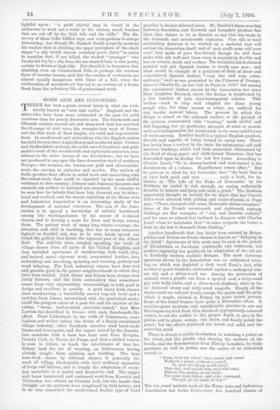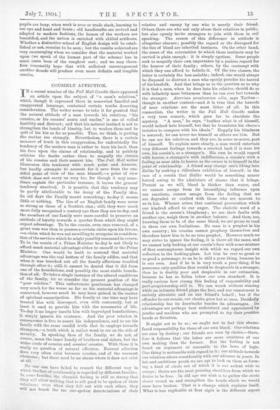HOME ARTS AND INDUSTRIES. T HERE has been a great revival
lately in what are tech- nically known as " arts and crafts." England and the sister-isles have been more celebrated in the past for solid creations than for purely decorative arts. The fourteenth and fifteenth century carved oak and stonework that has survived the ill-usage of civil wars, the wrought-iron work of Sussex and the flint work of East Anglia, are solid and imperishable facts. In needlework and embroidery also the English nation has held its own since Anglo-Saxon and mediteval days. Chelsea and Staffordshire pottery, the solid carved furniture and gold- smith's work of the seventeenth and eighteenth centuries, bear witness to the sober luxury of our forefathers ; but we have not produced in any ages the finer decorative work of southern Europe,—the mosaics, the beaten-out gold and silversmiths' work, the carving in alabaster and marble. The natives of India produce finer effects in metal work and enamelling with the rudest tools than could be equalled by the most skilful workman in this country ; Chinese and Japanese lacquers and enamels can neither be imitated nor surpassed. It remains to be seen how far talents that have lain dormant can be stimu- lated and evolved, and the recent exhibition of the Home Arts and Industries Association is an interesting study of the development of national resources. The aim of the Asso- ciation is to spread a knowledge of artistic handiwork among the working-classes by the means of technical classes, and to develop a taste for form and design among them. The patient work of many long winter evenings, the attention and skill in teaching, that has in many instances lighted on fruitful soil, was to be seen lately spread out round the gallery that forme the topmost part of the Albert Hall. The exhibits were, roughly speaking, the work of village classes from all parts of the United Kingdom, and they included specimens of woodcarving, both solid, chip, and incised, metal repousse work, ornamental leather, lace, embroidery and smocking, spinning and weaving, pottery and wood inlaying. The Irish industrial classes have done real and genuine good in the poorer neighbourhoods in which they have been started. Irish linens and friezes have always been justly famous, and the Irish embroidery that sometimes comes from very unpromising surroundings, is both good in design and excellent in quality. A good many Irish classes show woodcarving ; a beautifully carved bog-oak bowl and a turf-box from Ahane, intertwined with the symbolical snake, recall the pungent odour of a peat fire and the interior of the cabins, "warm, turf-scented, chocolate-tinted," that Miss Lawless has described in Crania with such Rembrandt-like effect. From Letterfrack in the wilds of Connemara, come baskets and wicker tables, the fruits of a firmly-established village industry ; other Southern counties send hand-made linens and homespuns, and the report issued by the Associa- tion mentions that a loom has been sent from Douglas, County Cork, to Tierra. del Fuego, and that a skilled weaver is soon to follow, to teach the inhabitants of that far. distant land the art of weaving, an Irishwoman having already taught them spinning and knitting. The bent iron-work shown by different classes, is generally the work of village blacksmiths with their ordinary apparatus of forge and bellows, and is simply the adaptation of every. day materials to a useful and decorative end. The copper and brass hammered and embossed work from Keswick and Yattendon has almost an Oriental look, but the hands that brought out the patterns wei e roughened by field-labour, and in no wise resembled the small-honed flexible type of hand peculiar to darker-skinned races. Mr. Ruskin's linen-weaving industry flourishes, and Keswick and Langdale produce fine linen that claims to be as durable as any that was made in the sixteenth and seventeenth centuries. Fine silk or wool' embroidery deserves to be worked on a material that will outlast the decoration itself, and of such stuffs none will ever excel that made of pure flax-thread, though the still finer make with silk weft and linen warp is exquisitely flexible and- has an artistic finish and surface. The beautiful old-fashioned painted and gilt Spanish leather is rarely seen now ; and what would be thought of a petticoat of cloth of silver and embroidered Spanish leather, " very fine and very extra- ordinary," such as was presented to the Princess of Orange, sister to Charles II., on her visit to Paris in 1656 ? but among the ornamental leather shown by the Association was some• from Leighton Buzzard, where the design is heightened by a few touches of pale semi-transparent colours. This. leather - work is very well adapted for those young people who, for some reason or, other, are unfitted for- any harder manual labour. The process by which the design is raised on the softened leather, or the ground of the pattern ornamented with " tooling," needs skilful and deft fingering, but no particular strength of wrist or muscle such as is indispensable for metal-work or the more solid forms• of wood-carving. Leather itself is a typical English product, durable and capable of being turned to many uses. There has lately been a revival in the taste for substantial calf and morocco bindings, which had been somewhat obliterated by the flood of cheap paper and cloth-bound literature that has descended upon us during the last few years. According to Charles Lamb, "To be strong-backed and neat-bound is the- desideratum of a volume. Magnificence comes after." But he goes on to allow for his favourites that " the book that is at once both good and rare such a book, for in- stance, as ' The Life of the Duke of Newcastle,' by his. Duchess, no casket is rich enough, no casing sufficiently durable, to honour and keep safe such a jewel." The Duchess- apparently thought so herself, for we know that her Grace's folios were adorned with gilding and coats-of-arms, as Pope says, "There, stamped with arms, Newcastle shines complete."' Some of the French seventeenth and eighteenth century bindings are fine examples of " rich and durable caskets," and for once we almost feel inclined to disagree with Charles Lamb when he maintains that "in some respects the better a. book is, the less it demands from binding."
Another handicraft that has lately been revived by Metro. politan and Bolton-on-Swale classes is known as "Inlaying in. the Solid." Specimens of this work may be seen in the panels of Elizabethan or Jacobean cupboards and bedsteads, but modern ingenuity has produced an adaptation of the old art in decidedly modern realistic designs, The most elaborate specimen shown by the Association was an unfinished table.. top, on which was depicted a dark wood Noah's Ark, with mother-o'-pearl windows, contrasted against a mahogany sun- set sky and a silver-wood sea. Among the procession of animals were a giraffe cut from a spotted root, a tulip-wood pig with holly tusks, and a silver-wood elephant, while in the air fluttered ebony and holly-wood seagulls. Nearly all the- shades used are natural woods, except the green and the grey, which is maple, stained in France by some secret process.. Some of the inlaid frames have quite a Florentine effect. It requires great neatness and considerable practice to saw out the shapes required from thin sheets of appropriately-coloured veneer, to cut the socket to the proper depth, to glue in the pieces, and to plane, scrape, rub down, and finally polish thee' panel; but the effects produced are broad and solid, and the- colouring good.
There is always a subtle fascination in watching a potter at his wheel, and the plastic clay obeying the motions of his. hands, and the demonstrator from Kirkby Lonsdale, by trade gardener as well as potter, was the centre of an interested crowd :- "Turn, turn my wheel ! turn round and round. Without a pause, without a sound;
So spins the flying world away ! This clay, well mixed with marl and sand, Follows the motion of my hand;
For some must follow, and some command, Though all are made of clay, !"
The ten years' patient work of the Home Arts and Industries. Association has borne fruit,—over five hundred classes of pupils are busy, when work is over or trade slack, learning to use eye and hand and brain ; old handicrafts are revived and -adapted to modern fashions, the homes of the workers are 'beautified, and the nation is enriched with skilled artificers. Whether a distinctive school of English design will be estab- lished or not, remains to be seen ; but the results achieved are 'very encouraging when we consider that the material worked upon (we speak of the human part of the scheme) has in some eases been of the roughest sort ; and we may there- fore reasonably hope that with sufficient encouragement another decade will produce even more definite and tangible results:,











































 Previous page
Previous page